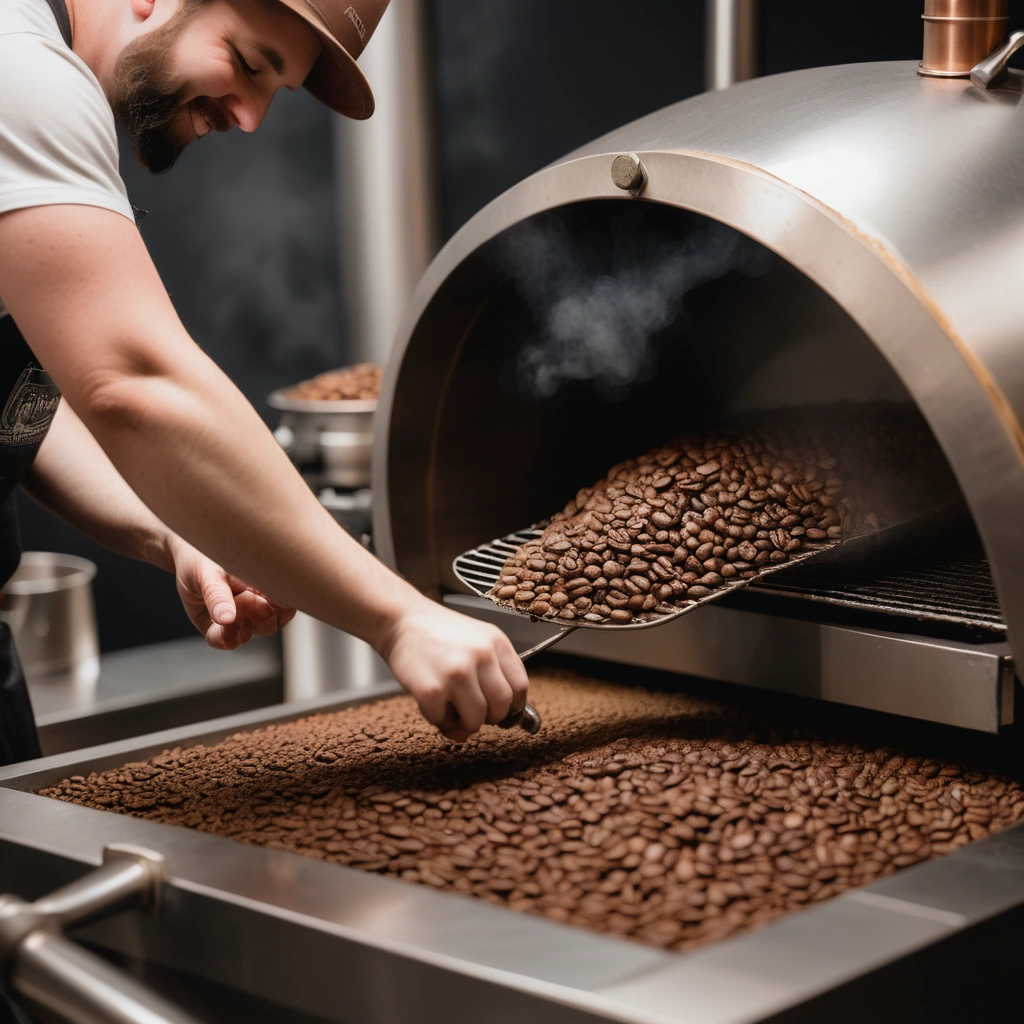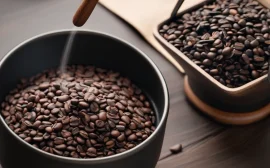Introduction: The Alchemy of Coffee Roasting
The quest for the perfect cup of coffee often begins with a journey into the art and science of roasting. More than just heating beans, artisan coffee roasting is about orchestrating a complex chemical transformation, primarily the Maillard reaction, to unlock a symphony of flavors. This article delves into the nuances of this process, offering a comprehensive guide for experienced home roasters, aspiring professionals, and coffee enthusiasts eager to deepen their understanding of flavor development.
We’ll explore various coffee roasting techniques, delve into the science behind the Maillard reaction coffee, and provide practical advice for manipulating roast profiles to achieve your desired flavor characteristics. Forget pork flavored coffee for now, let’s focus on the bean. For the home coffee roasting mastery guide audience, understanding these principles is paramount to achieving consistent and desirable results, transforming raw green beans into aromatic, flavorful roasts tailored to individual preferences. Central to mastering artisan coffee roasting is a deep understanding of how different coffee roasting profiles affect single-origin beans.
For example, a light roast might accentuate the delicate floral and citrus notes of an Ethiopian Yirgacheffe, while a darker roast could bring out the chocolate and nutty undertones of a Sumatran Mandheling. The Maillard reaction coffee is not a one-size-fits-all process; its progression and impact vary significantly depending on the bean’s origin, density, and moisture content. Experimentation and careful observation are key to unlocking the unique potential of each bean. By meticulously adjusting time, temperature, and airflow, roasters can sculpt flavor profiles that highlight the inherent qualities of the coffee.
Advanced coffee extraction techniques are intrinsically linked to the roasting process. A poorly roasted bean, regardless of its origin, will invariably yield a subpar cup. Conversely, a perfectly roasted bean can be ruined by improper grinding, tamping, or water temperature. The goal is to optimize the extraction process to capture the full spectrum of flavors developed during roasting. For instance, a lighter roast often requires a finer grind and lower water temperature to avoid under-extraction, resulting in a sour or weak brew. Conversely, a darker roast may benefit from a coarser grind and slightly higher water temperature to prevent over-extraction, which can lead to a bitter or astringent taste. Understanding these interactions is crucial for consistently brewing exceptional coffee.
The Science of the Maillard Reaction in Coffee
At the heart of artisan coffee roasting lies the Maillard reaction, a non-enzymatic browning process that occurs between amino acids and reducing sugars. This pivotal reaction, commencing around 285°F (140°C), is responsible for the genesis of hundreds of flavor compounds that contribute to coffee’s nuanced aroma and taste. The specific compounds formed are contingent upon factors such as temperature gradients, roasting duration, moisture content within the beans, and the specific composition of amino acids and reducing sugars inherent in the green coffee beans.
A mastery of the Maillard reaction coffee is therefore crucial for orchestrating the development of desirable flavors, such as caramelization and chocolate notes, while mitigating the formation of undesirable attributes like bitterness or sourness. Understanding this chemical dance is the cornerstone of creating exceptional coffee roasting profiles. Furthermore, the Maillard reaction coffee is not a singular event but rather a cascade of interconnected reactions. As the temperature increases, different sets of compounds are formed, each contributing a unique element to the overall flavor profile.
Early stages might yield floral and fruity notes, while later stages contribute to more complex flavors like nuts, spices, and even smoky undertones. Skilled artisan coffee roasting involves carefully monitoring and controlling these stages to achieve the desired balance of flavors. This is where the art truly meets the science, as roasters use their experience and intuition to guide the process, constantly adjusting parameters to coax out the best from each batch of beans. Modern coffee roasting techniques leverage advanced sensor technology and software algorithms to precisely control and monitor the Maillard reaction.
Data loggers track bean temperature, rate of rise, and environmental conditions within the roaster, providing real-time feedback to the roaster. This allows for a more consistent and repeatable roasting process, enabling roasters to fine-tune their coffee roasting profiles and achieve exceptional flavor development coffee. Moreover, understanding how different coffee varieties and processing methods respond to the Maillard reaction is paramount. Washed coffees, for instance, tend to exhibit brighter acidity and cleaner flavors, while natural processed coffees often display more pronounced fruit and body. The roaster must adapt their approach based on these inherent characteristics to unlock the full potential of each bean. Ultimately, the Maillard reaction is the key to transforming humble green beans into a symphony of flavors, and mastering it is the ultimate goal of any serious coffee roaster.
Roasting Techniques and Flavor Development
Different roasting techniques, such as drum roasting, fluid bed roasting, and convection roasting, influence the Maillard reaction and the resulting flavor profile. Drum roasters, the most traditional type, use a rotating drum to heat the beans through conduction and convection. This method typically produces a more even roast and allows for greater control over the roasting process. Fluid bed roasters use hot air to suspend the beans, resulting in a faster and more uniform roast.
Convection roasters use hot air circulation to transfer heat to the beans, offering a balance between drum and fluid bed roasting. Each method has its advantages and disadvantages, and the choice of roasting technique depends on the desired flavor profile and the roaster’s preferences. The way you pour coffee also changes its flavor, so it is all connected. Within artisan coffee roasting, the nuances of each method significantly impact flavor development coffee. Drum roasting, favored for its ability to impart a nuanced, complex flavor, allows for meticulous control over the Maillard reaction coffee.
The longer roast times often associated with drum roasting contribute to a more developed sweetness and body, making it ideal for single-origin beans where highlighting inherent characteristics is paramount. Conversely, fluid bed roasting, with its rapid heat transfer, tends to produce a brighter, more acidic cup, which can be desirable for certain coffee roasting profiles, particularly those emphasizing floral or fruity notes. Understanding these fundamental differences is crucial for home roasters aiming to replicate or innovate upon established coffee roasting profiles.
Exploring the practical applications of coffee roasting techniques reveals how roasters manipulate these methods to achieve specific flavor outcomes. For instance, a roaster aiming to accentuate the chocolate and nutty notes of a Sumatran bean might opt for a slow, deliberate drum roast, carefully monitoring the bean temperature to avoid scorching while maximizing Maillard reaction coffee development. In contrast, a roaster seeking to highlight the vibrant acidity of an Ethiopian Yirgacheffe might employ a shorter, hotter convection roast, carefully managing airflow to prevent the beans from becoming baked or underdeveloped.
The key lies in understanding how each roasting method interacts with the unique characteristics of the bean, a skill honed through meticulous experimentation and careful observation. Furthermore, the choice of roasting technique often reflects a roaster’s individual philosophy and aesthetic preferences within artisan coffee roasting. Some roasters champion the traditional drum roaster for its perceived ability to impart a more “artisanal” quality to the final cup, emphasizing the roaster’s direct involvement in the process. Others embrace the efficiency and consistency of fluid bed or convection roasters, viewing these technologies as tools for achieving precise and repeatable results. Ultimately, the “best” roasting technique is subjective, dependent on the roaster’s goals, resources, and palate. However, a thorough understanding of each method’s strengths and weaknesses is essential for any aspiring home coffee roaster seeking to master the art of flavor development coffee and craft exceptional coffee roasting profiles.
Manipulating Roast Profiles for Desired Flavors
Manipulating roast profiles – the time, temperature, and airflow during roasting – is essential for achieving specific flavor characteristics. A longer roasting time at a lower temperature can promote sweetness and body, while a shorter roasting time at a higher temperature can enhance acidity and brightness. Airflow plays a crucial role in removing moisture and smoke from the roasting chamber, preventing the development of undesirable flavors. By carefully adjusting these parameters, roasters can fine-tune the Maillard reaction coffee and create unique flavor profiles tailored to their preferences.
For example, extending the Maillard phase can increase body, while shortening it can preserve acidity. Understanding how different coffee roasting profiles interact with single-origin beans is paramount in artisan coffee roasting. A washed Ethiopian Yirgacheffe, known for its delicate floral and citrus notes, might benefit from a shorter, brighter roast to accentuate its inherent acidity. Conversely, a Sumatran Mandheling, often earthy and full-bodied, could be enhanced by a longer, slower roast that develops its chocolate and spice undertones.
Mastering these nuances allows roasters to highlight the unique characteristics of each bean, showcasing the terroir and processing methods. Furthermore, advanced coffee extraction techniques are inextricably linked to the roast profile. A lighter roast, with its higher acidity, often requires a coarser grind and a shorter brew time to avoid over-extraction and bitterness. Darker roasts, being more soluble, typically benefit from a finer grind and a longer brew time. Dialing in the extraction parameters based on the specific roast profile is crucial for achieving optimal flavor development coffee in the final cup.
Consistent monitoring of total dissolved solids (TDS) and extraction yield provides valuable data for refining both the roast and brew processes. Ultimately, the art of manipulating roast profiles is a continuous learning process. Experimentation, meticulous record-keeping, and a deep understanding of the Maillard reaction in coffee are essential for consistently producing exceptional coffee. By embracing a scientific approach combined with an artistic sensibility, roasters can unlock a world of flavor possibilities and create coffee roasting profiles that truly stand out. The iterative process of roasting, brewing, and tasting allows for constant refinement of coffee roasting techniques, leading to ever-more nuanced and delightful results.
Expert Insights: Interviews with Artisan Roasters
We spoke with Sarah Miller, head roaster at ‘Bean There, Brewed That,’ a specialty coffee roaster celebrated for its innovative flavor profiles. ‘The key is understanding your equipment and your beans,’ Miller explains. ‘Each origin and processing method reacts differently to heat. We spend a lot of time experimenting with different coffee roasting profiles to find the sweet spot for each bean, meticulously logging data to understand how the Maillard reaction coffee unfolds under varying conditions.’ This experimentation is crucial in artisan coffee roasting, as it allows roasters to fine-tune their approach and consistently produce exceptional results.
Miller’s team uses a combination of sensory evaluation and data analysis to optimize each roast, ensuring that the unique characteristics of the bean are fully expressed. Another roaster, David Chen from ‘Global Grains,’ emphasizes the critical role of airflow in flavor development coffee. ‘Airflow is your friend,’ Chen says. ‘It helps to remove unwanted compounds and prevents the beans from tasting baked, allowing the more desirable flavors to shine through.’ Chen elaborates on how manipulating airflow can significantly impact the final cup.
Insufficient airflow can lead to a build-up of smoky or ashy flavors, while excessive airflow can result in a thin, underdeveloped taste. Mastering airflow is therefore a fundamental aspect of advanced coffee extraction techniques and achieving optimal coffee roasting profiles. Both Miller and Chen agree that consistency and attention to detail are paramount for achieving repeatable results in artisan coffee roasting. This involves not only carefully monitoring the roasting process but also meticulously tracking environmental factors such as humidity and ambient temperature, which can influence the rate of heat transfer. Furthermore, they stress the importance of regular maintenance and calibration of roasting equipment to ensure consistent performance. By adhering to these principles, roasters can minimize variability and consistently deliver high-quality coffee that showcases the full potential of each bean. The pursuit of mastery in coffee roasting techniques demands a commitment to both precision and continuous learning, as the nuances of the Maillard reaction coffee continue to reveal themselves through dedicated experimentation and observation.
Common Challenges and Solutions in Artisan Roasting
Artisan coffee roasting, while a rewarding pursuit, presents several challenges that home roasters and professionals alike must navigate. Uneven roasting, scorching, and stalling are among the most common pitfalls. Uneven roasting, resulting from inconsistent heat distribution or inadequate airflow, leads to a heterogeneous batch where some beans are underdeveloped while others are over-roasted, ultimately compromising the overall flavor profile. Scorching, characterized by a burnt or bitter taste, occurs when beans are exposed to excessive heat, often due to a poorly calibrated roaster or insufficient agitation.
Stalling, a phenomenon where the roasting process slows down or stops prematurely, typically results in underdeveloped flavors and a grassy or vegetal taste. Addressing these challenges requires a keen understanding of the Maillard reaction coffee and the nuanced interplay of heat, time, and airflow. To mitigate these issues, a multi-faceted approach is essential. Precise control over roasting parameters, including temperature, airflow, and drum speed (if applicable), is paramount. Regularly calibrating your equipment, particularly temperature sensors and airflow controls, ensures accurate readings and consistent performance.
Maintaining meticulous roast logs, documenting key metrics such as bean temperature, environmental temperature, and time, allows for data-driven adjustments and continuous improvement. Furthermore, proper equipment maintenance, including cleaning and inspecting the roaster, prevents mechanical issues that can contribute to inconsistent roasting. According to Klaus Thomsen, a world-renowned barista and roaster, ‘Consistency is the cornerstone of quality. Without meticulous record-keeping and equipment maintenance, achieving repeatable results in artisan coffee roasting is nearly impossible.’ Beyond equipment and data, mastering coffee roasting techniques requires a deep understanding of the bean itself.
Different bean densities, moisture contents, and processing methods necessitate tailored roast profiles. For instance, a dense, high-altitude bean may require a longer roasting time to fully develop its flavors, while a lower-density bean might scorch easily if subjected to excessive heat. Experimentation and careful observation are crucial for unlocking the unique potential of each bean. Understanding coffee roasting profiles and how they influence flavor development coffee is key. By systematically adjusting roast parameters and cupping (tasting) the results, roasters can fine-tune their approach and consistently produce exceptional coffee. The goal is to guide the Maillard reaction coffee, promoting the development of desirable flavor compounds while avoiding the formation of undesirable ones. This iterative process of roasting, evaluating, and refining is at the heart of artisan coffee roasting.
Conclusion: The Art of Continuous Refinement
Mastering the Maillard reaction and developing unique flavor profiles through artisan coffee roasting requires a synthesis of scientific knowledge, technical skill, and artistic intuition. A deep understanding of the Maillard reaction coffee, coupled with precise application of coffee roasting techniques, allows you to orchestrate flavor development coffee in ways previously unimaginable. By meticulously controlling time, temperature, and airflow, home coffee roasting enthusiasts can transform green beans into a spectrum of taste experiences, moving beyond simple roasting to crafting signature coffee roasting profiles.
The journey towards mastery involves diligent record-keeping and critical sensory evaluation. Each roast should be meticulously documented, noting bean origin, environmental conditions, and specific roast parameters. Taste each batch with a cupping protocol, identifying nuances in acidity, body, and aroma. Compare your results against established coffee roasting profiles for similar beans, noting deviations and adjusting your approach accordingly. This iterative process of experimentation and analysis is the cornerstone of artisan coffee roasting. Consider, for example, the impact of first crack on flavor.
Extending the time between first crack and the end of the roast can enhance sweetness and body, particularly in naturally processed beans. Conversely, a quicker roast through this phase might accentuate acidity and floral notes, ideal for washed Ethiopian varieties. Such nuanced adjustments, informed by both data and palate, demonstrate the power of continuous refinement. The pursuit of exceptional brews is a continuous process of refinement and discovery, a testament to the roaster’s dedication to the craft.
The Future of Artisan Coffee Roasting
The world of artisan coffee roasting stands on the cusp of a fascinating evolution, driven by relentless innovation in processing methods, roasting technologies, and extraction techniques. We are witnessing a surge in experimental fermentation techniques at origin, impacting the green coffee’s composition and, consequently, the Maillard reaction coffee. Roasters are now equipped with advanced data logging and analysis tools, providing unprecedented control over roast profiles and enabling precise flavor development coffee. This data-driven approach allows for the creation of highly customized coffee roasting profiles tailored to specific single-origin beans, pushing the boundaries of what’s possible in cup quality.
Stay curious, experiment fearlessly, and embrace the challenges that come with pushing the boundaries of flavor. Looking ahead, the integration of artificial intelligence and machine learning promises to further revolutionize coffee roasting techniques. AI-powered systems can analyze vast datasets of roast parameters, bean characteristics, and sensory evaluations to predict optimal roasting curves for achieving desired flavor outcomes. This technology has the potential to democratize artisan coffee roasting, empowering even small-scale roasters to consistently produce exceptional coffee.
The application of AI will not replace the roaster’s skill, but rather augment it, providing valuable insights and accelerating the learning process. This synergy between human expertise and artificial intelligence will undoubtedly shape the future of flavor development in coffee. The future of coffee roasting lies in the hands of those who are willing to explore, innovate, and share their passion for this remarkable beverage. It demands a deep understanding of the Maillard reaction, a willingness to experiment with different coffee roasting profiles, and a commitment to continuous learning. And remember, despite the technological advancements and the allure of novelty, the heart of great coffee remains in the quality of the bean and the artistry of the roast. The pursuit of exceptional coffee is a journey, not a destination, and the most rewarding experiences are often found in the relentless pursuit of perfection.



